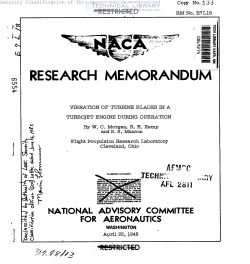naca-rm-e7l18
- Version
- 92 Downloads
- 910.19 KB File Size
- 1 File Count
- April 21, 2017 Create Date
- April 21, 2017 Last Updated
National Advisory Committee for Aeronautics, Research Memorandum - Vibration of Turbine Blades in a Turbojet Engine During Operation

An experimental investigation was conducted to determine the
vibration phenomena that occur in the turbine blades of a typical
Jet-propulsion engine during service operation; high—temperature
strain gages were used to measure the turbine-blade vibrations. At
turbine speeds within the cruising range, vibratory stresses of
appreciable magnitude existed in the blades. Mbst of the vibrations
observed at various turbine speeds occurred in the fundamental
bending mode of the blades at a frequency of approximately
1200 cycles per second. Vibrations also occurred in the first
torsional_mode at a frequency of approximately 2000 cycles per
second; and a high-frequency complex-mode vibration was observed
within the limits of.the cruising range of the engine. The
frequencies of the principal vibrations-were found to be related
to the number of nozzle blades and combustion chambers.
Among the important problems in the stress analysis of Jet-
propulsion engines is that of determining the vibratory phenomena
that affect turbine blades during service operation. Vibrations
may cause fatigue rupture of turbine blades. In an NAGA investiga-
tion of turbine-blade failures, for example, most of the broken
blades displayed the characteristic appearance of fatigue fracture,
indicating the presence of critical vibrations. The development of
the Jet-propulsion engine in England was complicated by numerous
turbine—blade vibration problems (reference 1). Little data are
available, however, on the quantitative magnitudes of vibratory
stresses present in typical gas-turbine blades under operating
conditions.
Numerous potential sources of blade-vibration excitation are
present in gas turbines. Most of the excitations are transmitted
to the blades by means of the hot gases constituting the driving
Security Classification of This Repori iae Been Cancelled
medium. Any influence that tends to produce a periodic variation
in velocity about the blade tends to produce vibration. Front
bearing supports, compressor blades, compressor—casing guide vanes,
combustion tubes, and stationary nozzles affect the uniformity of
the gas stream before it passes over the rotating blades. Even if
the gas.flow were perfectly uniform at the time of impulse in the
turbine blades, the passage over the blades might induce aerodynamic
conditions conducive to vibrations. Although the most serious
sources of excitation are probably the combustion tubes and the
stationary nozzle blades, no data are available for evaluating the
various excitation influences.
| File | Action |
|---|---|
| naca-rm-e7l18 Vibration of Turbine Blades in a Turbojet Engine During Operation.pdf | Download |

Comment On This Post